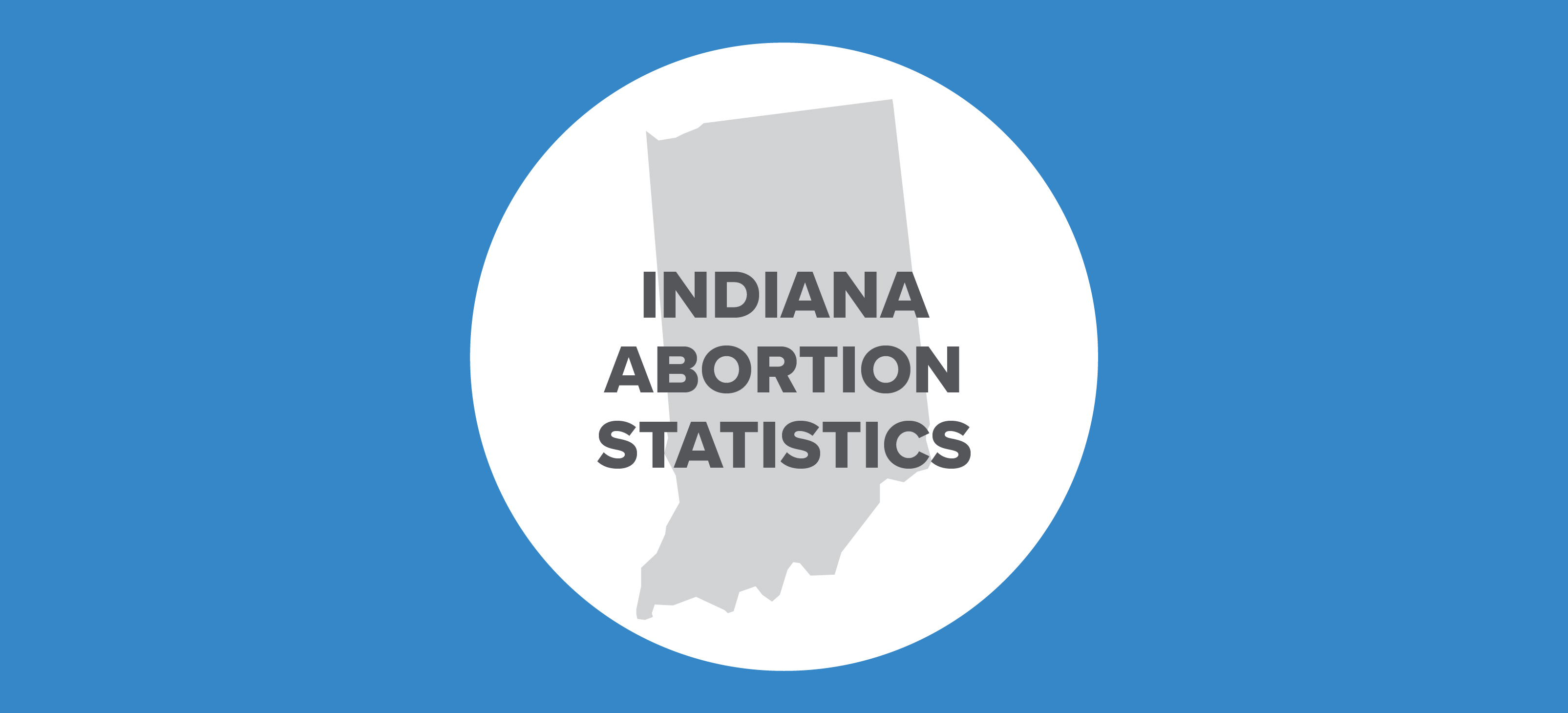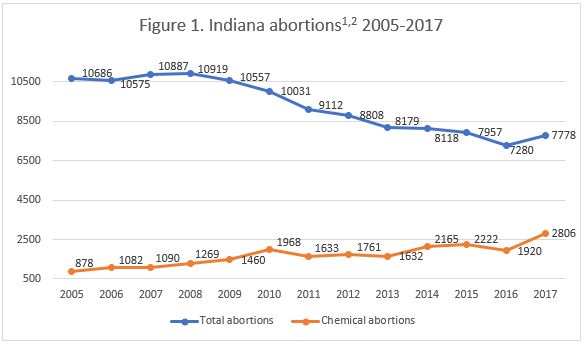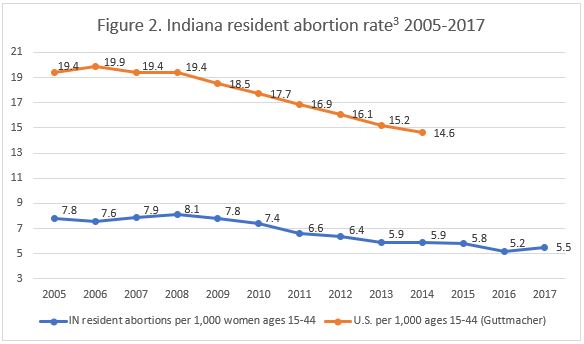Abortion Reporting: Indiana (2017)

Indiana’s annual abortion report for 2017, published on schedule in late June 2018, shows that abortions in the state have risen from the previous year. The 31-page report is published online by the Indiana State Department of Health.
Statistics and Changes in Indiana Abortions, 2016-2017

Abortion Totals and Trends
The past year saw a rise in abortions in Indiana, with abortions in the state increasing by seven percent from 7,280 in 2016 to 7,778 in 2017 (Fig. 1). Chemical abortions increased by an even greater percentage, rising by 46 percent from 1,920 in 2016 to 2,806 in 2017. In 2017, chemical abortions made up 36 percent of all abortions reported in Indiana. Since 2004, the first year Indiana reported chemical abortions as a separate category, chemical abortions have increased by almost 600 percent. However, total abortions have fallen by 38 percent from 1994, Indiana’s earliest reporting year. The increase may have been the result of a court order blocking an Indiana law requiring doctors to perform an ultrasound before performing an abortion. Indiana’s resident abortion rate in 2017 was 5.5 abortions per 1,000 resident women of childbearing age, up from 5.2 the year before (Fig. 2).
State Report Summary
Ninety-two percent of the abortions reported in Indiana in 2017 were performed on state residents. Ten percent were performed on women under the age of 20. A majority of women were in their twenties (61 percent), and over a quarter, 26 percent, were in their thirties. Just three percent were over age 40. More than half of the abortions in Indiana were performed on white women – 57 percent – while 31 percent were performed on black women and 13 percent on women of a different race. Most of the women getting abortions did not have a college degree. Eleven percent had less than a high school education, while 36 percent had graduated from high school and 27 percent had completed some college. Twenty-five percent had an associate’s degree or higher. A high majority of women, 87 percent, were not married.
Most women had experienced pregnancy before – only 29 percent reported no previous pregnancies. Thirty-eight percent of abortions were performed on women with no prior live births, while 26 percent had one previous birth and 36 percent had two or more. More than two-thirds of women were undergoing their first abortion (69 percent). Twenty-one percent reported one previous abortion and 10 percent reported more than one. A majority of women, 83 percent, had never suffered a miscarriage; 13 percent had one previous miscarriage, and four percent had more than one.
The majority of abortions took place in the first trimester. Seventy-nine percent occurred at eight weeks of gestation or earlier, and 21 percent occurred between nine and 13 weeks. In contrast, less than half a percent were performed in the second trimester. Twelve abortions were performed between 14 and 17 weeks gestation, and 16 abortions were performed between 18 and 20 weeks. According to the report, the latest abortion was performed at 19 weeks gestation. Indiana prohibits abortions after 20 weeks post-fertilization – more than five months. The state also requires that abortions after the first trimester be performed in a hospital or ambulatory surgical center.
The majority of abortions were performed by Planned Parenthood in its four Indiana abortion centers. Planned Parenthood accounted for more than 71 percent of the abortions performed in Indiana, similar to 73 percent the year before. Two other facilities, Clinic for Women and Indianapolis Women’s Center, were responsible for another 28 percent. Just 47 abortions were performed in hospitals. The month of March had the most abortions, 792, while July had the fewest, 555.
Complication Reporting
Indiana compares favorably to other states in its efforts to protect unborn life. Americans United for Life ranked the Hoosier State at 14th place in its 2018 Life List, which evaluates each state’s legal protections of life. However, Indiana has experienced recent setbacks in the courts. In March of 2018, Indiana passed a law requiring hospitals and physicians to report any abortion-related complications they treat, similar to laws passed by several other states. However, Planned Parenthood sued to prevent the law from going into effect, claiming that the law is too vague. Indiana’s law, which was set to take effect in early July, has been enjoined by a federal court. The state has accepted the ruling.
State Ranking
In a Charlotte Lozier Institute survey of state abortion reporting across the 50 states, the District of Columbia, and New York City, Indiana’s reports were ranked at fifth place. Unfortunately, recent court decisions have stymied Indiana’s efforts to improve the quality of its reporting. Still, Indiana could strengthen its reports by releasing data it already collects, such as information on abortions after viability, whether any babies are born alive during abortions, and whether any mothers die during or because of an abortion. The state already collects some information on complications resulting from abortion and could include this in its reports. As abortion continues to be a divisive issue at the state and federal level, accurate and thorough reporting is particularly relevant.


- Indiana’s report cautions that because of a change in analysis implemented in 2014, data analysis performed prior to 2012 is not comparable to analysis performed after 2012. Data for 2012-2015 were taken from the 2016 annual report. Data for 2016-2017 were taken from the 2017 annual report. Data for prior years were taken from the annual reports for each year. The 2017 report revised 2016 figures up slightly.
- Chemical abortion totals were produced here by adding all mifepristone and misoprostol procedures and all medical (non-surgical) procedures.
- Indiana calculated the rates for 2012-2016 using the following formula: (total resident abortions ÷ resident women ages 15-44) x 1,000. Prior to 2012, Indiana calculated the rates using the following formula: (abortions to residents ages 15-44 ÷ resident women ages 15-44) x 1,000.
























